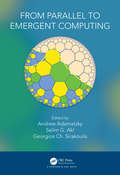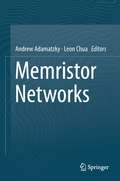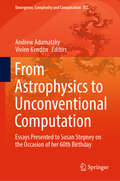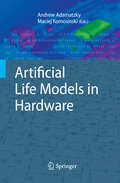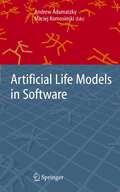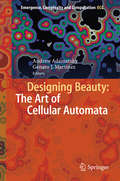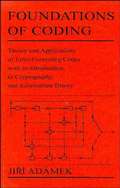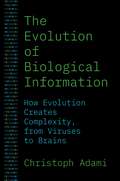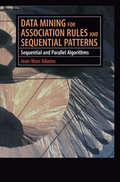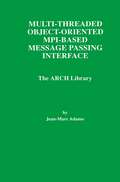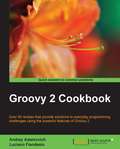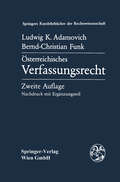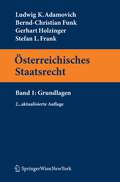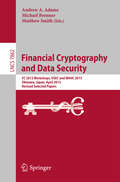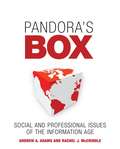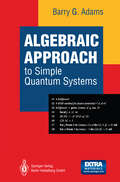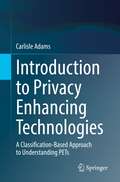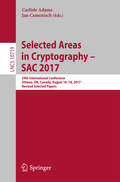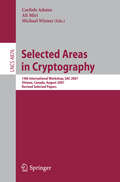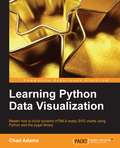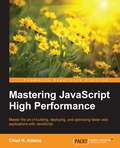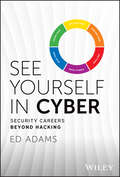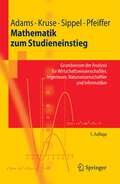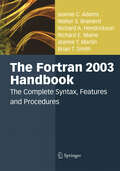- Table View
- List View
From Parallel to Emergent Computing
by Andrew Adamatzky Selim Akl Georgios Ch. SirakoulisModern computing relies on future and emergent technologies which have been conceived via interaction between computer science, engineering, chemistry, physics and biology. This highly interdisciplinary book presents advances in the fields of parallel, distributed and emergent information processing and computation. The book represents major breakthroughs in parallel quantum protocols, elastic cloud servers, structural properties of interconnection networks, internet of things, morphogenetic collective systems, swarm intelligence and cellular automata, unconventionality in parallel computation, algorithmic information dynamics, localized DNA computation, graph-based cryptography, slime mold inspired nano-electronics and cytoskeleton computers. Features Truly interdisciplinary, spanning computer science, electronics, mathematics and biology Covers widely popular topics of future and emergent computing technologies, cloud computing, parallel computing, DNA computation, security and network analysis, cryptography, and theoretical computer science Provides unique chapters written by top experts in theoretical and applied computer science, information processing and engineering From Parallel to Emergent Computing provides a visionary statement on how computing will advance in the next 25 years and what new fields of science will be involved in computing engineering. This book is a valuable resource for computer scientists working today, and in years to come.
Memristor Networks
by Andrew Adamatzky Leon ChuaUsing memristors one can achieve circuit functionalities that are not possible to establish with resistors, capacitors and inductors, therefore the memristor is of great pragmatic usefulness. Potential unique applications of memristors are in spintronic devices, ultra-dense information storage, neuromorphic circuits and programmable electronics. Memristor Networks focuses on the design, fabrication, modelling of and implementation of computation in spatially extended discrete media with many memristors. Top experts in computer science, mathematics, electronics, physics and computer engineering present foundations of the memristor theory and applications, demonstrate how to design neuromorphic network architectures based on memristor assembles, analyse varieties of the dynamic behaviour of memristive networks and show how to realise computing devices from memristors. All aspects of memristor networks are presented in detail, in a fully accessible style. An indispensable source of information and an inspiring reference text, Memristor Networks is an invaluable resource for future generations of computer scientists, mathematicians, physicists and engineers.
From Astrophysics to Unconventional Computation: Essays Presented to Susan Stepney on the Occasion of her 60th Birthday (Emergence, Complexity and Computation #35)
by Andrew Adamatzky Vivien KendonThis Festschrift is a tribute to Susan Stepney’s ideas and achievements in the areas of computer science, formal specifications and proofs, complex systems, unconventional computing, artificial chemistry, and artificial life. All chapters were written by internationally recognised leaders in computer science, physics, mathematics, and engineering. The book shares fascinating ideas, algorithms and implementations related to the formal specification of programming languages and applications, behavioural inheritance, modelling and analysis of complex systems, parallel computing and non-universality, growing cities, artificial life, evolving artificial neural networks, and unconventional computing. Accordingly, it offers an insightful and enjoyable work for readers from all walks of life, from undergraduate students to university professors, from mathematicians, computers scientists and engineers to physicists, chemists and biologists.
Artificial Life Models in Hardware
by Andrew Adamatzky Maciej KomosinskiHopping, climbing and swimming robots, nano-size neural networks, motorless walkers, slime mould and chemical brains - "Artificial Life Models in Hardware" offers unique designs and prototypes of life-like creatures in conventional hardware and hybrid bio-silicon systems. Ideas and implementations of living phenomena in non-living substrates cast a colourful picture of state-of-art advances in hardware models of artificial life.
Artificial Life Models in Software
by Andrew Adamatzky Maciej KomosinskiAn informal introduction and guidance to modern software tools for modeling and simulation of life-like phenomena, this book offers detailed reviews of contemporary software for artificial life for both professionals and amateurs.
Designing Beauty: The Art of Cellular Automata (Emergence, Complexity and Computation #20)
by Andrew Adamatzky Genaro J. MartínezThis fascinating, colourful book offers in-depth insights and first-hand working experiences in the production of art works, using simple computational models with rich morphological behaviour, at the edge of mathematics, computer science, physics and biology. It organically combines ground breaking scientific discoveries in the theory of computation and complex systems with artistic representations of the research results. In this appealing book mathematicians, computer scientists, physicists, and engineers brought together marvelous and esoteric patterns generated by cellular automata, which are arrays of simple machines with complex behavior. Configurations produced by cellular automata uncover mechanics of dynamic patterns formation, their propagation and interaction in natural systems: heart pacemaker, bacterial membrane proteins, chemical rectors, water permeation in soil, compressed gas, cell division, population dynamics, reaction-diffusion media and self-organisation. The book inspires artists to take on cellular automata as a tool of creativity and it persuades scientists to convert their research results into the works of art. The book is lavishly illustrated with visually attractive examples, presented in a lively and easily accessible manner.
Foundations of Coding: Theory and Applications of Error-Correcting Codes with an Introduction to Cryptography and Information Theory
by Jiri AdamekAlthough devoted to constructions of good codes for error control, secrecy or data compression, the emphasis is on the first direction. Introduces a number of important classes of error-detecting and error-correcting codes as well as their decoding methods. Background material on modern algebra is presented where required. The role of error-correcting codes in modern cryptography is treated as are data compression and other topics related to information theory. The definition-theorem proof style used in mathematics texts is employed through the book but formalism is avoided wherever possible.
The Evolution of Biological Information: How Evolution Creates Complexity, from Viruses to Brains
by Christoph AdamiWhy information is the unifying principle that allows us to understand the evolution of complexity in natureMore than 150 years after Darwin&’s revolutionary On the Origin of Species, we are still attempting to understand and explain the amazing complexity of life. Although we now know how evolution proceeds to build complexity from simple ingredients, quantifying this complexity is still a difficult undertaking. In this book, Christoph Adami offers a new perspective on Darwinian evolution by viewing it through the lens of information theory. This novel theoretical stance sheds light on such matters as how viruses evolve drug resistance, how cells evolve to communicate, and how intelligence evolves. By this account, information emerges as the central unifying principle behind all of biology, allowing us to think about the origin of life—on Earth and elsewhere—in a systematic manner.Adami, a leader in the field of computational biology, first provides an accessible introduction to the information theory of biomolecules and then shows how to apply these tools to measure information stored in genetic sequences and proteins. After outlining the experimental evidence of the evolution of information in both bacteria and digital organisms, he describes the evolution of robustness in viruses; the cooperation among cells, animals, and people; and the evolution of brains and intelligence. Building on extensive prior work in bacterial and digital evolution, Adami establishes that (expanding on Dobzhansky&’s famous remark) nothing in biology makes sense except in the light of information. Understanding that information is the foundation of all life, he argues, allows us to see beyond the particulars of our way of life to glimpse what life might be like in other worlds.
Data Mining for Association Rules and Sequential Patterns: Sequential and Parallel Algorithms
by Jean-Marc AdamoRecent advances in data collection, storage technologies, and computing power have made it possible for companies, government agencies and scientific laboratories to keep and manipulate vast amounts of data relating to their activities. This state-of-the-art monograph discusses essential algorithms for sophisticated data mining methods used with large-scale databases, focusing on two key topics: association rules and sequential pattern discovery. This will be an essential book for practitioners and professionals in computer science and computer engineering.
Multi-Threaded Object-Oriented MPI-Based Message Passing Interface: The ARCH Library (The Springer International Series in Engineering and Computer Science #446)
by Jean-Marc AdamoMulti-Threaded Object-Oriented MPI-Based Message Passing Interface: The ARCH Library presents ARCH, a library built as an extension to MPI. ARCH relies on a small set of programming abstractions that allow the writing of well-structured multi-threaded parallel codes according to the object-oriented programming style. ARCH has been written with C++. The book describes the built-in classes, and illustrates their use through several template application cases in several fields of interest: Distributed Algorithms (global completion detection, distributed process serialization), Parallel Combinatorial Optimization (A* procedure), Parallel Image-Processing (segmentation by region growing). It shows how new application-level distributed data types - such as a distributed tree and a distributed graph - can be derived from the built-in classes. A feature of interest to readers is that both the library and the application codes used for illustration purposes are available via the Internet. The material can be downloaded for installation and personal parallel code development on the reader's computer system. ARCH can be run on Unix/Linux as well as Windows NT-based platforms. Current installations include the IBM-SP2, the CRAY-T3E, the Intel Paragon, PC-networks under Linux or Windows NT. Multi-Threaded Object-Oriented MPI-Based Message Passing Interface: The ARCH Library is aimed at scientists who need to implement parallel/distributed algorithms requiring complicated local and/or distributed control structures. It can also benefit parallel/distributed program developers who wish to write codes in the object-oriented style. The author has been using ARCH for several years as a medium to teach parallel and network programming. Teachers can employ the library for the same purpose while students can use it for training. Although ARCH has been used so far in an academic environment, it will be an effective tool for professionals as well. Multi-Threaded Object-Oriented MPI-Based Message Passing Interface: The ARCH Library is suitable as a secondary text for a graduate level course on Data Communications and Networks, Programming Languages, Algorithms and Computational Theory and Distributed Computing and as a reference for researchers and practitioners in industry.
Groovy 2 Cookbook
by Andrey Adamovich Luciano FiandesioThis book follows a Cookbook style and is packed with intermediate and advanced level recipes.This book is for Java developers who have an interest in discovering new ways to quickly get the job done using a new language that shares many similarities with Java. The book's recipes start simple, therefore no previous Groovy experience is required to understand the code and the explanations accompanying the examples.
Österreichisches Verfassungsrecht: Verfassungsrechtslehre unter Berücksichtigung von Staatslehre und Politikwissenschaft (Springers Kurzlehrbücher der Rechtswissenschaft)
by Ludwig K. Adamovich Bernd-Christian FunkBuchmann, Frau Gisela Klammer, Frau Dr. Gudrun Maurer, Herr Dr. Franz Merli und Herr Dr. Armin Stolz am Institut tiitig. Unser Dank gilt gleichermagen jenen Mitarbeitern, die in der Zwischenzeit aus dem Personalstand des Insti tuts ausgeschieden sind. Wien/Graz, im Oktober 1982 Ludwig K. Adamovich Bernd-Christian Funk Vorwort zur zweiten Auflage Die zweite A uflage des Lehrbuches ist als N achdruck der ersten in Verbin dung mit einem vorangestellten Erganzungsteil gestaltet. Der Text der ersten Auflage ist bis auf die Korrektur von Druckfehlern gleichgeblieben. Der Er in der Rechts ganzungsteil bietet eine Ubersicht iiberwichtige Veranderungen lage und Verfassungswirklichkeit, die sich seit der ersten Auflage ergeben ha ben. Die systematische Einarbeitung dieser und kommender Anderungen so wie der Entwicklungen in Lehre und Rechtsprechung bleibt einer spater fol genden Neuauflage vorbehalten. Wir hoffen, auf diese Weise dem Bediirfnis nach Information iiber den aktuellen Stand des Staatsrechts und des Verfassungslebens in entsprechender Weise Rechnung zu tragen. Der Wegfall des Untertitels des Buches auf der erst en Umschlagseite hat drucktechnische Griinde. In der positiven Auf nahme, die das Buch seit seinem Erscheinen im Spatherbst 1982 gefunden hat, sehen wir eine Bestatigung unseres Bemiihens urn eine moglichst vielseitige Betrachtungsweise des osterreichischen Verfassungsrechts.
Österreichisches Staatsrecht: Band 1: Grundlagen (Springers Kurzlehrbücher der Rechtswissenschaft)
by Ludwig K. Adamovich Bernd-Christian Funk Gerhart Holzinger Stefan FrankDidaktisch und wissenschaftlich auf höchstem Niveau, behandelt dieser Band - in aktualisierter Neuauflage - die Grundlagen des österreichischen Staatsrechts. Von der Verfassungsgeschichte und den Baugesetzen spannt sich der Bogen über die Mitgliedschaft Österreichs in der EU und in der Staatengemeinschaft hin zu dem verfassungsrechtlichen Verhältnis von Bund und Ländern. Die verständliche Sprache, die hervorragende Gliederung des Stoffes und das ausführliche Sachverzeichnis in Verbindung mit höchstem wissenschaftlichen Anspruch werden Studenten wie auch Praktiker zu diesem Band ebenso gerne greifen lassen wie zu den früheren Lehrbüchern der Autoren.
Financial Cryptography and Data Security: FC 2013 Workshops, USEC and WAHC 2013, Okinawa, Japan, April 1, 2013, Revised Selected Papers (Lecture Notes in Computer Science #7862)
by Andrew A. Adams Michael Brenner Matthew SmithThis book constitutes the thoroughly refereed post-conference proceedings of the workshop on Usable Security, USEC 2013, and the third Workshop on Applied Homomorphic Cryptography, WAHC 2013, held in conjunction with the 17th International Conference on Financial Cryptology and Data Security, FC 2013, in Okinawa, Japan. The 16 revised full papers presented were carefully selected from numerous submissions and cover all aspects of data security. The goal of the USEC workshop was to engage on all aspects of human factors and usability in the context of security. The goal of the WAHC workshop was to bring together professionals, researchers and practitioners in the area of computer security and applied cryptography with an interest in practical applications of homomorphic encryption, secure function evaluation, private information retrieval or searchable encryption to present, discuss, and share the latest findings in the field, and to exchange ideas that address real-world problems with practical solutions using homomorphic cryptography.
Pandora's Box, eTextbook: Social and Professional Issues of the Information Age
by Andrew A. Adams Rachel J. McCrindleComputing technology is constantly evolving and changing, developing and consolidating its position as a vital component of our lives. It no longer plays a minor part in society – it is embedded in, and affects, all aspects of life, from education to healthcare to war. Dealing with the implications of this is a major challenge, and one that can impact upon us, both personally and professionally. As a consequence, it is vital that all in the computing industry make wise decisions regarding their conduct. Using case studies and discussion topics drawn from entertaining real world examples, Pandora’s Box examines the background of a wide range of vital contemporary issues, encouraging readers to examine the social, legal and ethical challenges they will face in their own careers. Written in an engaging style and packed with international examples, this book addresses topics which have come to the forefront of public consciousness in recent years, such as online crime, piracy and peer to peer file sharing. Comprehensive coverage is provided of digital entertainment, censorship and privacy issues, presenting a rich source of context in which to consider ethical matters. Suitable for students on computer science degree programmes, as well as those taking IT related modules on other courses which consider the impact of technology on 21st century living, Pandora’s Box is an essential read and a unique and timely textbook.
Algebraic Approach to Simple Quantum Systems: With Applications to Perturbation Theory
by Barry G. AdamsThis book provides an introduction to the use of algebraic methods and sym bolic computation for simple quantum systems with applications to large order perturbation theory. It is the first book to integrate Lie algebras, algebraic perturbation theory and symbolic computation in a form suitable for students and researchers in theoretical and computational chemistry and is conveniently divided into two parts. The first part, Chapters 1 to 6, provides a pedagogical introduction to the important Lie algebras so(3), so(2,1), so(4) and so(4,2) needed for the study of simple quantum systems such as the D-dimensional hydrogen atom and harmonic oscillator. This material is suitable for advanced undergraduate and beginning graduate students. Of particular importance is the use of so(2,1) in Chapter 4 as a spectrum generating algebra for several important systems such as the non-relativistic hydrogen atom and the relativistic Klein-Gordon and Dirac equations. This approach provides an interesting and important alternative to the usual textbook approach using series solutions of differential equations.
Introduction to Privacy Enhancing Technologies: A Classification-Based Approach to Understanding PETs
by Carlisle AdamsThis textbook provides a unique lens through which the myriad of existing Privacy Enhancing Technologies (PETs) can be easily comprehended and appreciated. It answers key privacy-centered questions with clear and detailed explanations.Why is privacy important? How and why is your privacy being eroded and what risks can this pose for you? What are some tools for protecting your privacy in online environments? How can these tools be understood, compared, and evaluated? What steps can you take to gain more control over your personal data?This book addresses the above questions by focusing on three fundamental elements:It introduces a simple classification of PETs that allows their similarities and differences to be highlighted and analyzed;It describes several specific PETs in each class, including both foundational technologies and important recent additions to the field;It explains how to use this classification to determine which privacy goals are actually achievable in a given real-world environment. Once the goals are known, this allows the most appropriate PETs to be selected in order to add the desired privacy protection to the target environment. To illustrate, the book examines the use of PETs in conjunction with various security technologies, with the legal infrastructure, and with communication and computing technologies such as Software Defined Networking (SDN) and Machine Learning (ML).Designed as an introductory textbook on PETs, this book is essential reading for graduate-level students in computer science and related fields, prospective PETs researchers, privacy advocates, and anyone interested in technologies to protect privacy in online environments.
Selected Areas in Cryptography – SAC 2017: 24th International Conference, Ottawa, ON, Canada, August 16-18, 2017, Revised Selected Papers (Lecture Notes in Computer Science #10719)
by Carlisle Adams Jan CamenischThis book contains revised selected papers from the 24th International Conference on Selected Areas in Cryptography, SAC 2017, held in Ottawa, ON, Canada in August 2017. The 23 full papers presented in this volume were carefully reviewed and selected from 66 submissions. The focus of the conference was on specific themes in the area of cryptographic system design and analysis such as:Design and analysis of symmetric key cryptosystemsPrimitives for symmetric key cryptography, including block and stream ciphers, hash functions, and MAC algorithmsEfficient implementations of symmetric and public key algorithms
Selected Areas in Cryptography: 14th International Workshop, SAC 2007, Ottawa, Canada, August 16-17, 2007, Revised Selected Papers (Lecture Notes in Computer Science #4876)
by Carlisle Adams Ali Miri Michael WienerHere, more than two dozen papers on some of the latest subject areas in cryptography have been selected for publication. They represent the refereed post-proceedings of the 14th International Workshop on Selected Areas in Cryptography, SAC 2007, held in Ottawa, Canada, in August 2007. Chosen from more than 70 submissions, they cover a huge array of topics including stream cipher cryptanalysis, modes of operation and side-channel attacks. Online files and updates are included.
Learning Python Data Visualization
by Chad AdamsIf you are a Python novice or an experienced developer and want to explore data visualization libraries, then this is the book for you. No prior charting or graphics experience is needed.
Mastering JavaScript High Performance
by Chad R. AdamsIf you are a JavaScript developer with some experience in development and want to increase the performance of JavaScript projects by building faster web apps, then this book is for you. You should know the basic concepts of JavaScript.
See Yourself in Cyber: Security Careers Beyond Hacking
by Ed AdamsA one-of-a-kind discussion of how to integrate cybersecurity into every facet of your organization In See Yourself in Cyber: Security Careers Beyond Hacking, information security strategist and educator Ed Adams delivers a unique and insightful discussion of the many different ways the people in your organization—inhabiting a variety of roles not traditionally associated with cybersecurity—can contribute to improving its cybersecurity backbone. You’ll discover how developers, DevOps professionals, managers, and others can strengthen your cybersecurity. You’ll also find out how improving your firm’s diversity and inclusion can have dramatically positive effects on your team’s talent. Using the familiar analogy of the color wheel, the author explains the modern roles and responsibilities of practitioners who operate within each “slice.” He also includes: Real-world examples and case studies that demonstrate the application of the ideas discussed in the book Many interviews with established industry leaders in a variety of disciplines explaining what non-security professionals can do to improve cybersecurity Actionable strategies and specific methodologies for professionals working in several different fields interested in meeting their cybersecurity obligationsPerfect for managers, directors, executives, and other business leaders, See Yourself in Cyber: Security Careers Beyond Hacking is also an ideal resource for policymakers, regulators, and compliance professionals.
See Yourself in Cyber: Security Careers Beyond Hacking
by Ed AdamsA one-of-a-kind discussion of how to integrate cybersecurity into every facet of your organization In See Yourself in Cyber: Security Careers Beyond Hacking, information security strategist and educator Ed Adams delivers a unique and insightful discussion of the many different ways the people in your organization—inhabiting a variety of roles not traditionally associated with cybersecurity—can contribute to improving its cybersecurity backbone. You’ll discover how developers, DevOps professionals, managers, and others can strengthen your cybersecurity. You’ll also find out how improving your firm’s diversity and inclusion can have dramatically positive effects on your team’s talent. Using the familiar analogy of the color wheel, the author explains the modern roles and responsibilities of practitioners who operate within each “slice.” He also includes: Real-world examples and case studies that demonstrate the application of the ideas discussed in the book Many interviews with established industry leaders in a variety of disciplines explaining what non-security professionals can do to improve cybersecurity Actionable strategies and specific methodologies for professionals working in several different fields interested in meeting their cybersecurity obligationsPerfect for managers, directors, executives, and other business leaders, See Yourself in Cyber: Security Careers Beyond Hacking is also an ideal resource for policymakers, regulators, and compliance professionals.
Mathematik zum Studieneinstieg: Grundwissen der Analysis für Wirtschaftswissenschaftler, Ingenieure, Naturwissenschaftler und Informatiker (Springer-Lehrbuch)
by Gabriele Adams Hermann-Josef Kruse Diethelm Sippel Udo PfeifferStudierende in den Fächern Wirtschaftswissenschaften, Technik, Naturwissenschaften und Informatik benötigen zum Studienbeginn bestimmte Grundkenntnisse in der Mathematik, die im vorliegenden Buch sehr ausführlich dargestellt werden. Es behandelt die Grundlagen der Analysis im Sinne einer Wiederholung/Vertiefung des gymnasialen Oberstufenstoffes. Der Stoff wird schrittweise erklärt und anhand vieler Beispiele aus verschiedenen Disziplinen illustriert. Aufgaben (mit Lösungen) dienen der Einübung. Wiederholtes Aufgreifen der Anwendungsbeispiele regen zur Auseinandersetzung mit den verschiedenen Themen an. Durch die breite Darstellung ist das Buch insbesondere für die Wiederholung oder den Erwerb des Wissens im Selbststudium (auch für Schüler im Leistungskurs Mathematik) geeignet.Aus einer Besprechung zur 4. Auflage:„Ein Buch, das so manchem helfen wird, doch noch Gefallen an der Mathematik zu finden." (Studium - WS 2002/2003)
The Fortran 2003 Handbook: The Complete Syntax, Features and Procedures
by Jeanne C. Adams Walter S. Brainerd Richard A. Hendrickson Richard E. Maine Jeanne T. Martin Brian T. SmithThe Fortran 2003 Handbook is a definitive and comprehensive guide to Fortran 2003 and its use. Fortran 2003, the latest standard version of Fortran, has many excellent features that assist the programmer in writing efficient, portable and maintainable programs. This all-inclusive volume offers a reader-friendly, easy-to-follow and informal description of Fortran 2003, and has been developed to provide not only a readable explanation of features, but also some rationale for the inclusion of features and their use. This highly versatile handbook is intended for anyone who wants a comprehensive survey of Fortran 2003.
